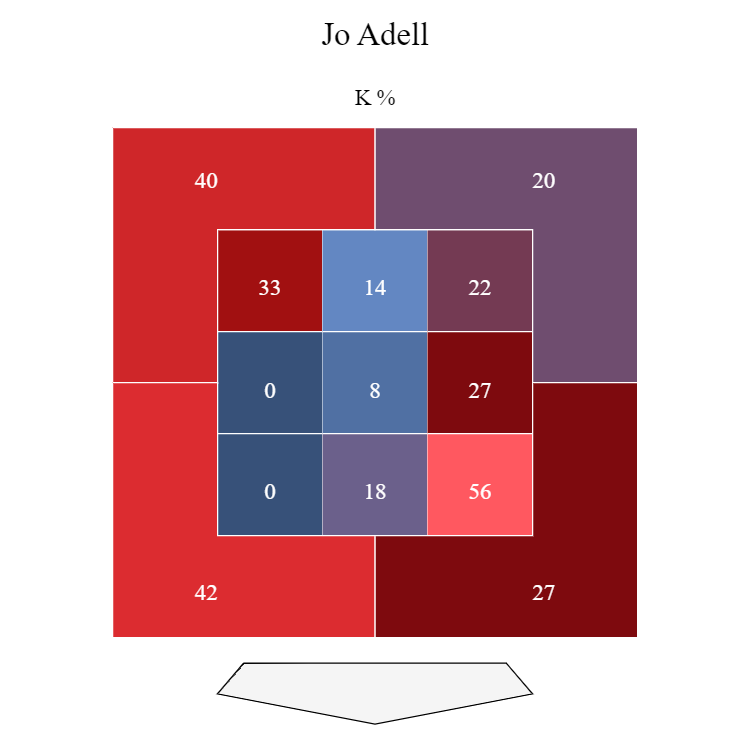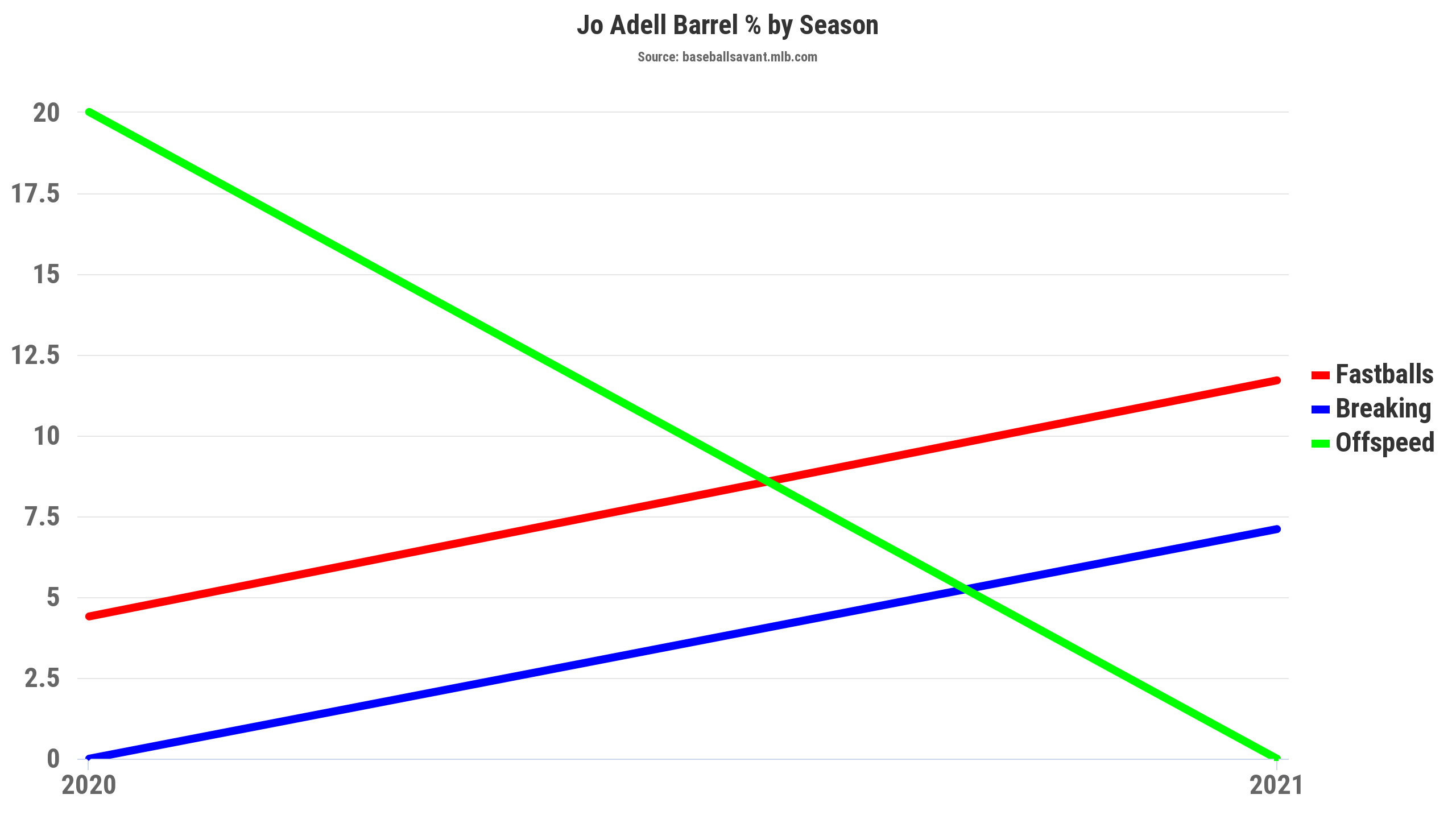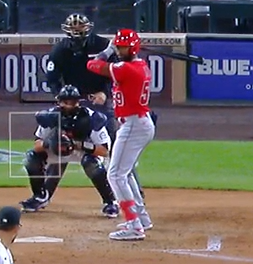Going into the 2020 MLB season, there weren’t many prospects in baseball more hyped than Jo Adell. The Angels’ No. 1 prospect in 2019 and 2020 (as well as the No. 6 and No. 3 prospect in baseball overall, in 2019 and 2020, respectively) according to Baseball America, Adell was expected to help complement Mike Trout in the outfield, and boost an Angels lineup that would compete in the AL West for years to come, along with Shohei Ohtani and Anthony Rendon.
Unfortunately, Adell’s early career in Los Angeles (or Anaheim, specifically), has been rocky thus far, though the COVID-pandemic of 2020 certainly didn’t help things.
Without a Minor League season, the Angels rushed Adell to the Big Leagues in 2020, even though he had played in only 27 games in Triple-A Salt Lake and posted a 67 wRC+ at that level in 2019.
Granted, Adell did mash Double-A pitching as a 20-year-old, as he posted a 173 wRC+ and a slash of .308/.390/.553. However, that 2019 stint too wasn’t a huge sample, as he only played in 43 games and accumulated 182 plate appearances with the Mobile BayBears of the Southern League.
Hence, it is likely that if there were a Minor League season in 2020, Adell would have taken some time in Triple-A Salt Lake to get more at-bats against professional pitching. Instead, the Angels management promoted Adell on August 5th, and unfortunately, their prized prospect floundered in his Major League debut in 2020.
When looking at Adell’s stat line, not much went right for Adell in 2020.
As a 21-year-old, he posted a triple slash of .161/.212/.266 which included a K rate of 41.7 percent, a BB/K ratio of 0.13, and a wRC+ of 27. Furthermore, he also accumulated an fWAR of -1.4 in his first Major League season, thus showing that things didn’t go right for Adell both at the plate and on the field defensively as well.
The Angels were much more prudent in 2021 with Adell, letting him play 73 games and accumulate 339 plate appearances with Triple-A Salt Lake to begin the season. After posting a .289/.342/.592 slash which included 23 home runs and a wRC+ of 122, the Angels promoted him in early August, not a bad time considering the Angels’ disappointing place in the AL West standings.
At the surface level, Adell’s metrics do not look great. In 35 games and 140 plate appearances, he only hit .246 with a 90 wRC+, and his BB/K ratio of 0.25 still hint at some plate discipline issues. That being said, while fantasy managers may be down on Adell’s outlook after two sub-par short stints in the Majors, he still is capable of being a star player in the Angels outfield, maybe as soon as next season.
Because when diving into his metrics from the past two seasons, as well as looking at his swing adjustments, there are seeds in place for Adell to have a “breakout” season at the Major League level in 2022.
Increasing Contact; Decreasing Strikeouts
While the surface-level metrics from 2021 don’t look impressive, Adell’s improvement in making contact and cutting down on strikeouts last season are encouraging signs that Adell is making improvements at the Major League level (which should be more fully realized in 2022).
In terms of making contact, Adell not only decreased his overall whiff rate significantly from 2020 to 2021 (12.4 percent to be specific), but he also increased his contact rates in pitches both inside and outside of the strike zone. He did this by employing a more aggressive approach at the plate, as his swing rate increased three percent, and his first pitch swing percentage increased by 12.6 percent from 2020 to 2021, as evidenced in the table below:
The fact that Adell made more contact in 2021 despite swinging more than in 2020 is a sign that his pitch recognition is improving at the Major League level with more plate appearances. That improvement is also further confirmed when looking at Adell’s rolling expected wOBA chart over his career via Baseball Savant, as Adell saw a huge positive spike after his 250th plate appearance at the Major League level.

Thus, this spike, along with the contact increase, all demonstrate that things at the plate were starting to click for Adell in 2021 and that he is capable of carrying this over in 2022, as long as he’s fully healthy (he was put on the 10-Day IL on September 15th due to an abdominal strain and missed the remainder of the season as a result).
Another key thing to note about Adell’s contact improvement was his improvement in minimizing the strikeouts in an area of the strike zone that he struggled with immensely in 2020.
Let’s take a look at Adell’s K zone chart from the 2020 season, via Baseball Savant:

Notice how much Adell strikes out in those outside edge areas, specifically zone 3, 6, and 9. He also struggled in zone 2, that up and middle part of the strike zone, as that area was the third-worst zone for him on a K rate end in 2020.
Now, let’s take a look at his K zone chart from last year:

As demonstrated in the chart above, Adell improved significantly in zones 3, 6, and 9 in 2021, seeing double-digit drops in all three of those outside zones. Furthermore, he saw a significant gain in zone 2, which went from 50 percent two seasons ago to a much more palatable 14 percent in 2021.
Thus, it’s not a surprise that Adell saw his overall K rate go from 41.7 percent in 2020 to only 22.9 percent in 2021. This data shows that Adell is recognizing pitches better at the Major League level, as well as making adjustments in his swing to make contact better and more frequently against big league pitchers.
A Surge in Barrels (Especially Against Fastballs)
While Adell’s increase in contact rate is important to note, what matters most for a corner outfielder like Adell is “productive contact”. That can be measured in his barrel rate, which also saw positive gains in 2021.
In 2020, Adell generated a barrel rate of 4.6 percent, which ranked him in the bottom 20th percentile in that category that season, according to Baseball Savant. Last season, however, his barrel rate increased to 9.1 percent, and what was most significant about this increase in overall rate was that Adell improved on barreling fastballs and breaking balls in 2021, which can be seen in the chart below:

Two seasons ago, Adell barreled less than five percent of fastballs and didn’t barrel many breaking balls. He barreled changeups well at around 20 percent but considering he only saw offspeed pitches 8.4 percent of the time in 2020, it’s not a significant sample where much can be taken away.
Last season, however, he was able to barrel nearly 12.5 percent of fastballs, and 7.5 percent of breaking balls, a significant improvement against both pitches. While the barrel rate against offspeed pitches did go down, the gains in the fastball and breaking ball barrel rate make up for that offspeed decline. After all, he saw fastball pitches 60.1 percent of the time and breaking balls 30 percent of the time in 2021 (in comparison to offspeed pitches, which he saw 9.9 percent of the time).
In addition, the barrel rate increase against fastballs also correlates with a lot of Adell’s overall success against fastball pitches last season.
Here’s a look at how Adell fared in 2020 and 2021 against fastball pitches, and the significant gains in multiple categories is a positive sign for his outlook at the plate going forward:
Pitchers tried to take advantage of him at the plate last season with the pitch, as they increased their usage of fastballs by 4.5 percent from 2020. Despite that increase, Adell improved by 96 points in wOBA against the pitch, whiffed 7.9 percent less, and saw a 13.3 percent decline in put-away percentage.
If Adell can continue to see these kinds of gains against the pitch in 2022, he not only could improve even more in important statistical categories (especially surface-level ones like average, slugging, etc.), but he could thrust himself into the discussion as one of the better hitting corner outfielders in the American League West as soon as next season.
Adell’s Adjustment in Stance and Swing
Last season, Adell was much better at making contact, striking out less, and barreling the ball last season. All those things are evident in the data detailed above.
That being said, how did Adell get there, and is it sustainable in the long term?
Well, a partial answer to that question may lie in the adjustment he made with his stance from 2020 to 2021, and how that affected his overall swing (in a positive way).
Here’s a look at Adell’s swing during his rookie season in 2020, as he strikes out on a four-seam fastball thrown right down the middle by the Rockies’ Carlos Estevez:
https://gfycat.com/decisiveastonishingaustraliansilkyterrier
Now, here’s a screenshot of his stance before Estevez’s pitch:

Adell has his hands high, but he holds his front elbow up, which causes the bat to rest flat near his shoulders. In addition to being up, his front elbow is also really far away from his body. This contributes to extra movement in his stance, which in turn, prevents Adell from getting his hands quickly through the strike zone.
To compensate, Adell tries to speed things up in his load and stride, and his swing becomes loopy as a result.
Therefore, instead of crushing a straight four-seamer for an extra-base hit, Adell instead strikes out against Estevez, unable to get around the pitch, even though it’s in a very hittable area.
Let’s flash forward a season and take a look at Adell hitting a four-seamer against the Tigers’ Gregory Soto for a grand slam bomb, which gives the Angels the lead in the top of the ninth inning at Comerica Park:
https://gfycat.com/wellgroomedtanhairstreakbutterfly
Soto pumps this four-seamer at 97 MPH, and in that upper middle part of the zone where Adell struck out 50 percent of the time in 2020. This time around though, Adell turns on the heater and crushes it over the left-field wall, much to the dismay of Tigers fans and Soto that evening (as you could tell from Soto’s face in the clip).
Now, let’s take a look at the image of Adell in the batter’s box before the pitch:

It’s amazing to see the adjustments Adell made in his stance from 2020 to 2021.
His hands and elbows are tighter to his body, and his stance and back are more upright in 2021 than in 2020. It’s a key reason why he’s able to connect on that pitch from Soto up in the strike zone, as he can get his hands more quickly through the strike zone with this stance adjustment.
If he had the same stance and hand placement from 2020, he would have whiffed on that Soto fastball, as he did against Estevez in Colorado in the previous clip.
What’s interesting to note about his adjustment is that it seems like Adell is reverting to his original swing from his high school days. As evidenced from this Tweet from Baseball America in 2020, Adell employed a tighter, more upright stance as a higher schooler before he was drafted, and that eventually changed once Adell transitioned to playing professional ball in the Angels farm system:
Wanna see how a swing can progress over a couple years?
On the left is Jo Adell in high school.
On the right is the swing of the No. 3 prospect in baseball. https://t.co/ulLqloPgF1 pic.twitter.com/GDIB2bOtmA
— Baseball America (@BaseballAmerica) April 10, 2020
That being said, Adell’s swing, even with the adjustments, is far from perfect.
Yes, he made more contact and was able to barrel fastballs better with this adjustment (especially in particular areas of the strike zone he struggled against in 2020). However, his average exit velocity on batted balls dropped from 90.6 MPH in 2020 to 86.2 MPH, and it seemed like his more “compact” swing constricted him at times from fully getting around pitches, much like this pop out against the Padres’ Blake Snell in September:
https://gfycat.com/meeksnivelingdogwoodclubgall
Adell’s stance and swing adjustment certainly helped him improve in 2021. However, it will be interesting to see what further adjustments he’ll make this offseason and Spring so he can tap into his power more consistently, and be an even bigger force in the Angels lineup in 2022.
Where Does Adell Stand Fantasy-Wise in 2022?
According to Pitcher List’s Jonathan Metzelaar’s 2022 Hitter Rankings from October, Adell ranked 149th out of 150 (he was above Andrew McCutchen). Thus, I compared Adell to other hitters ranked in the same tier, which included Gavin Lux, Garrett Hampson, Cavan Biggio, and LaMonte Wade.
Here’s is how the five hitters compared in fantasy rankings, as of January 2nd:
According to an average of Fantrax, NFC, and Fantasy Pros rankings, Adell ranked slightly higher than Wade and Hampson, but significantly lower than Lux (nearly 71 spots) and Biggio (roughly 46 spots). Even though Adell has some long-term value due to his age, especially in Dynasty formats, it seems as Adell may get under drafted or overlooked by fantasy managers come draft time.
When it came to comparing the five in terms of advance metrics, Adell ranked third last season in wRC+ and second in ISO. Furthermore, his K rate was the second-lowest of the bunch as well, which is shown in the table below:
Lastly, in terms of Stacast metrics, Adell did rank last of the group in terms of average exit velocity and launch angle. However, he ranked second in barrel rate, as evidenced in the table below, which was an interesting outlier considering how much he lagged behind the other four hitters in the other two categories:
Yes, average exit velocity and launch angle matter. That being said, Adell’s barrel rate shouldn’t be ignored. It is possible, that based on barrel rate data and progression, Adell may have the most upside of these five for 2022 and beyond.
There’s no question that Adell has not quite lived up to the hype of his lofty prospect status these past couple of years. However, Adell demonstrated some solid progression from 2020 to 2021, and of the five in that lower Tier 12 hitter category, Adell is by far the highest-upside option of the bunch. He should get more playing time in the Angels outfield in 2022, and he could have more RBI opportunities as well, especially if Mike Trout and Anthony Rendon are fully healthy.
Adell is ready for his breakout season in 2022…
And baseball fans and fantasy managers should take notice sooner rather than later.
Photo by Brian Rothmuller/Icon Sportswire | Adapted by Justin Redler (@reldernitsuj on Twitter)


I drafted him in my dynasty league two years ago. I had really high hopes but eventually had to cut bait to the big swing and miss in his profile. I’ve been keeping tabs though and hope he makes the adjustments he needs. I do feel the Angels rushed him and the COVID seasons didn’t help his development either. I’m still holding out hope for him.
Great article btw
Thanks for reading! I think he made some incremental progress, thanks to some of his adjustments in stance and swing. His swing was a lot more conservative in 2021 than in 2020, because I think he knew he was swinging WAY too big in his rookie debut. It showed in him cutting down in the strikeout rate, but the EV numbers show that he may have given up a little more consistent power for more contact (though the barrel rate refutes that, as his barrel rate went up, which is interesting).
I think if Adell had stayed healthy in September, he would’ve had a strong finish and we would be talking about him more. It will certainly be a battle for him to find a balance between that “big swing” of his rookie year, and the tighter, more conservative approach of his sophomore season. If he can find that adjustment, he could really get hot and be a steal for a lot of fantasy managers.
At Triple A last year, he still put up decent HR numbers (23 in 311 AB). Even with the more conservative, are we still seeing 30+ HR at the MLB level? My concern is that his K rate was still 31% last year. My glimmer of hope is that every time Adell advanced thru the minors, there way always an adjustment period. I do believe he has the pedigree to figure it out eventually, although I have a feeling, similar to Buxton, it might take a little longer than expected.
I didn’t follow him closely in AAA last year, but I wonder if the K rate could’ve been credited to those swing adjustments. I would love to see what his swing looked like at the start of AAA, and if it looked similar or different from his swing in September. Of course, I haven’t looked at the splits, but I wonder if he went through some adjustments which led to a higher K rate in AAA at the start of the year.
I agree with you about Adell’s ability to make an adjustment, and I wonder how quickly that adjustment will happen in 2022. I think Adell is a better dynasty option than leagues where there’s a re-draft every year, but I think he still could be valuable next year, especially since he’s going so low right now. I think there’s 30+ homer, .300 average potential still, though I think it may be more in the 20-25 range and .260-.280 range in 2022. But I think your Buxton comparison is valid, though I’m not sure if he has the speed upside of Buxton (but I think he has better batting average upside than Buxton).
As an Angels fan I’ve tracked his progress for years now and I seem to remember the FO wanting to see better plate discipline in 2021 before an eventual call up. His BB/K rates at AAA SLC show a slight improvement from May-June to July.
May 98AB 6BB 36K
June 104AB 7BB 34K
July 102AB 9BB 26K
This improvement and the fact the Angels were starting the likes of Juan Lagares and Kean Wong in the OF seems to have convinced them he was ready.
Excellent article.